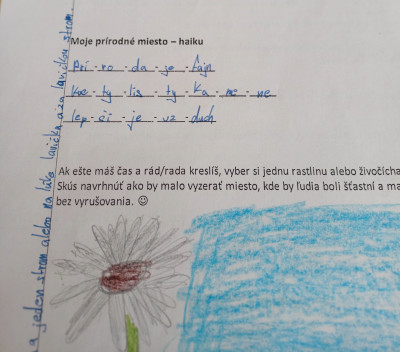My Natural Place Haiku
Pupils perceive the vibrant energy of nature and involve the senses in observation. Pupils will record their magic moment of (re)connection with nature in the form of haiku and/or drawing.
Age range: 9-12 years
Duration: 30-45 minutes
Biomimicry Connection:
We humans are children of nature and need to restore a deep connection with nature for our physical and mental health. This activity helps pupils connect with nature.
Activity Details:
Tools and Materials
- Paper, pupil worksheet and pencil/coloured pencils
Preparation
- Outdoor activity
Description
- Ask every pupil to find their own place in the school garden, in the park, in the forest, by the river, or other suitable outdoor space where they feel comfortable and the place charges them with energy.
- The teacher says: "Follow the voice of your heart. Find your own place where nothing and no one will disturb you, where you can comfortably sit and create for 15 minutes. Let your mind rest and focus on your surroundings.” Each pupil works independently.
- After pupils find their natural place, they look at the questions in the worksheet:
- What are you sitting on? Is it warm, cold, dry, wet, sharp, soft, pleasant, unpleasant?
- Are there any living creatures around you (bugs, butterflies, ants, birds, people)?
- What can you perceive with your senses?
- What do you see?
Can you hear any sounds? - What do you touch?
- What do you smell?
- Now discover the artist of life in yourself. Put what you feel into a short Haiku poem. As the name suggests, it comes from Japan. Each poem consists of three lines that have 5, 7 and 5 syllables respectively. It can look like this, for example:
Net-tle-is-sting-ing (5 syllables about the place that is around you)
The-bee-tle-wan-ders-a-round (7 syllables about an animal or a plant)
Ten-min-utes-a-lone (5 syllables about what you are experiencing)
If you still have some time left, you can draw the subject of your haiku.

Extensions
1. Pupils can observe the elements of biophilic design.
Is the colour of the bark of the tree or the grass uniform?
What is more pleasing to your eye, an area of just one colour or an area where different colours complement each other?
Do we see rectangular shapes and sharp edges in nature?
What sounds of nature did you record?
How did it feel to breathe fresh air?
2. Observation activity: Magic spot
Pupils sit silently without the need to answer questions. They just need the right guidance and a little practice. Their experience becomes much deeper as a result.
Introduce spending time in solitude in nature. Guide pupils to a spot at least 10 meters from the next pupil. Placing pupils in this way reduces opportunity for distraction e. g. by sitting too close to a friend. Providing a mat to sit on also helps younger pupils to sit still. Invite them to just sit in silence for 10-20 minutes (depending on age). Bring pupils together afterwards, no need to ask for feedback unless the group wishes to talk. If so, ask two or three pupils to share is a usual and helpful conclusion. It can also help pupils to appreciate the usefulness of this activity if they are to repeat it later again.
An addition to this, pupils can be provided with a piece of card with a strip of double-sided tape attached. Ask them to record their experience using natural objects from their magic spot. They stick them to the piece of card using the double-sided tape.
3. For older pupils: Haiku about the talents of a chosen inspiring animal or plant
Writing a haiku might help pupils look more closely at their species, and learn its special talents. For more able pupils, could they be encouraged to write a haiku about the special talents of their chosen species.
Additional Information
Learn more about Haiku (here).
Read about biophilic design in schools (here).
Explore different patterns in biophilic design (here).